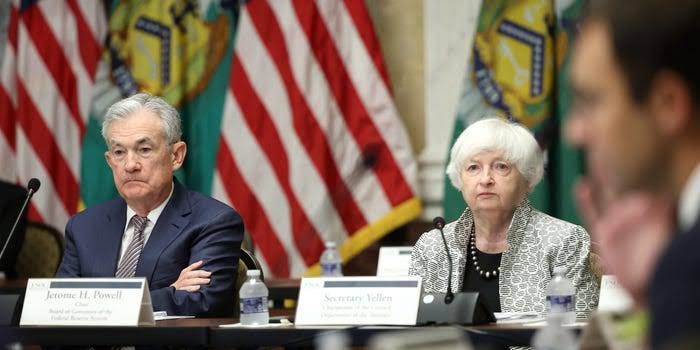The Role of Yield Curve Inversion in Predicting U.S. Recession Periods: A Historical Perspective
- Cuneyt Tuncer
- 13 Ağu 2024
- 4 dakikada okunur
Güncelleme tarihi: 23 Kas 2024

The relationship between the Federal Reserve’s policy interest rate and the yield on 10-year U.S. Treasury bonds has long been closely monitored by economists and investors alike. The difference between these two indicators plays a crucial role in predicting imminent recessions. The graph under examination contrasts two critical economic indicators: the red line representing periods of recession in the United States and the black line depicting the spread between the policy interest rate and the 10-year Treasury yield. This analysis explores how these indicators signal the entry and exit of the U.S. economy into and out of recessionary periods.
Entering a Recession: The Role of Yield Curve Inversion as a Predictor
In economic cycles, the difference between short-term interest rates (typically the federal funds rate) and long-term yields (such as the 10-year Treasury yield) is regarded as a reliable indicator of upcoming recessions. When the yield curve inverts—that is, when short-term rates exceed long-term rates—the black line on the graph dips into negative territory. This inversion is commonly interpreted as a harbinger of economic downturns.
1. Historical Examples: The graph shows that before every major recession, the black line dips below zero, indicating an inverted yield curve. This phenomenon was notably observed before the recessions of 1980, 1990, 2000, 2008, and 2020. This economic condition is typically associated with investor behavior: when there is an expectation of economic uncertainty or a downturn, investors demand higher yields on short-term investments, which is seen as a signal of deteriorating economic conditions.
2. Economic Interpretation: An inverted yield curve often suggests that monetary policy has become too restrictive relative to economic conditions. When the Federal Reserve raises short-term interest rates to control inflation or cool an overheated economy, long-term rates may not rise proportionately due to expectations of slowing economic growth or an impending recession. Therefore, the inversion reflects a pessimistic outlook on the economy’s future performance.

This situation generally indicates that investors perceive heightened short-term economic risks. In anticipation of slower economic growth or rising inflation, investors shift towards long-term bonds. As a result, the yield curve inverts. Historically, economic downturns have followed these inversions.
Exiting a Recession: The Normalization of the Yield Curve
As the economy begins to recover from a recession, the yield curve typically normalizes, and the black line returns to positive territory. This normalization reflects improving economic expectations and a belief that higher future growth will require higher yields.
1. Post-Recession Recovery: During recession periods (marked by the red line), the yield curve usually remains flat or inverted due to ongoing economic uncertainty. However, as recovery begins, the Federal Reserve often lowers short-term interest rates to stimulate growth, and long-term yields start to rise with expectations of a stronger economy. The graph demonstrates that following the recessions of 1980, 1991, 2001, and 2009, the black line returned to positive territory, signaling renewed optimism for long-term economic growth.
This recovery is often linked to the control of inflation and the central bank’s broader monetary expansion policies. Such policies indicate that long-term economic growth is sustainable. Investors, anticipating higher future returns, redirect their investments to long-term bonds, which causes the yield curve to shift back to a positive slope.
2. Market Dynamics: The return of the black line to positive territory generally coincides with increased investor confidence and a shift in market expectations toward growth. This phase is characterized by rising corporate profit expectations, increased consumer spending, and overall improving economic conditions.
As investor confidence grows, an optimistic market atmosphere develops. This situation leads to increased consumer spending and prompts companies to raise their growth expectations. These signals of economic recovery help maintain a positive yield curve, contributing to the re-establishment of economic stability.
General Assessment and Conclusions
This graph serves as an effective tool for highlighting the significance of the yield curve as an economic indicator. The consistent inversion of the yield curve before recessions and its normalization during recovery periods underscore its importance in economic forecasting. Understanding this relationship is crucial for investors and policymakers alike, as it enables them to predict economic cycles and make strategic decisions accordingly.
1. Investment Strategy: Monitoring the yield curve can provide investors with early warnings of potential economic downturns, enabling more strategic asset allocation decisions. For instance, an inverted yield curve might signal a shift towards defensive investments.
Economic cycles significantly influence investment strategies. Investors may adjust their portfolios in response to the recessions that typically follow yield curve inversions. This might include shifting to less risky asset classes or reassessing the risks associated with current investments.
2. Policy Implications: For the Federal Reserve and other policymakers, movements in the yield curve can guide decisions on interest rates and other monetary policy tools. Recognizing the signals provided by the yield curve can help fine-tune policies to mitigate the severity of recessions or delay their onset.
Central banks can monitor yield curve inversions and adjust monetary policies accordingly. This approach is crucial for timing measures to prevent economic overheating or to soften the impact of recessions. Furthermore, these signals can guide decisions on setting interest rates and managing market expectations.
Conclusion
In conclusion, the relationship between yield curve dynamics and recession periods is of critical importance to both investors and policymakers. This graph powerfully illustrates the ability of the yield curve to predict economic downturns and recoveries. This analysis provides crucial insights into the health and direction of future economic activities and facilitates strategic decision-making. A thorough understanding of this relationship by both investors and policymakers plays a vital role in managing economic cycles and ensuring the long-term stability of the economy.
Donation >>>>>>>https://www.cuneyttuncer.com/team
#economy #finance #federalreserve #marketing #bankofjapan #nasdaq100 #inflation #yieldcurve #treasury #USA #europa



Yorumlar